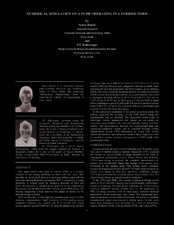| dc.contributor.other | International Pump Users Symposium (23rd : 2007) | |
| dc.creator | Rawal, Sonia | |
| dc.creator | Kshirsagar, J. T. | |
| dc.date.accessioned | 2017-10-05T15:22:21Z | |
| dc.date.available | 2017-10-05T15:22:21Z | |
| dc.date.issued | 2007 | |
| dc.identifier.uri | https://hdl.handle.net/1969.1/163937 | |
| dc.description | Lecture | en |
| dc.description | pg. 21 | en |
| dc.description.abstract | This paper deals with pump as turbine (PAT) as a feasible solution to the energy problems in rural and hilly areas. PAT provides an economical alternative to actual turbines especially for pico and microhydropower generation. PAT is essentially a pump operating in turbine mode by changing direction of flow and hence the direction of rotation of the impeller. In the forthcoming discussion, an introduction to this concept is provided along with reasons suggesting a high potential for pump as turbine in the present energy scenario. With an objective of investigating computational tools for PAT analysis, computational fluid dynamics (CFD) analysis using computer software was carried out on a mixed flow pump having specific speed of 4843 in U.S. units. In pump mode, the best efficiency flow was 0.100 m3/sec at 8.3 m (5.35 ft3/sec at 27.23 ft) head at 1450 rpm. Results were compared with data available from experimental test for parameters like head number, power number, and the efficiency versus the discharge number. The numerical model of PAT (in the turbine mode) exhibits very good characteristics with a maximum operating efficiency of 83.10 percent at a flow rate of 0.127 m3/sec (4.49 ft3/sec) or 2014 gpm at 12.48 m (40.95 ft) head while operating at a speed of 1450 rpm. The specific speed in turbine mode is 4019 in U.S. units. The similarity between experimental and numerical results has been satisfactory. In the numerical simulation of the pump in turbine mode, the authors analyzed the accuracy of the CFD model using the experimental data as standard. The numerical model helps to investigate various parameters that cannot (or not easily) be measured experimentally like internal hydraulic losses and flow pattern. The discrepancies between the experimental data and numerical simulation results can be removed through further improvement in the CFD simulation by using finer mesh, numerical schemes, and turbulence models. More experience will be needed to realize accurate convergence of CFD results with experimental data | en |
| dc.format.medium | Electronic | en |
| dc.format.mimetype | application/pdf | |
| dc.language.iso | en | |
| dc.publisher | Texas A&M University. Turbomachinery Laboratories | |
| dc.relation.ispartof | Proceedings of the 23rd International Pump Users Symposium | en |
| dc.subject.lcsh | Pumping machinery | en |
| dc.title | Numerical Simulation On A Pump Operating In A Turbine Mode | en |
| dc.type.genre | Presentation | en |
| dc.type.material | Text | en |
| dc.identifier.doi | https://doi.org/10.21423/R1WD5C | |


